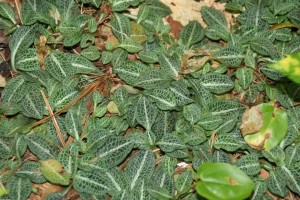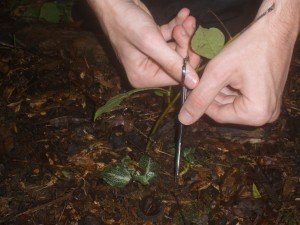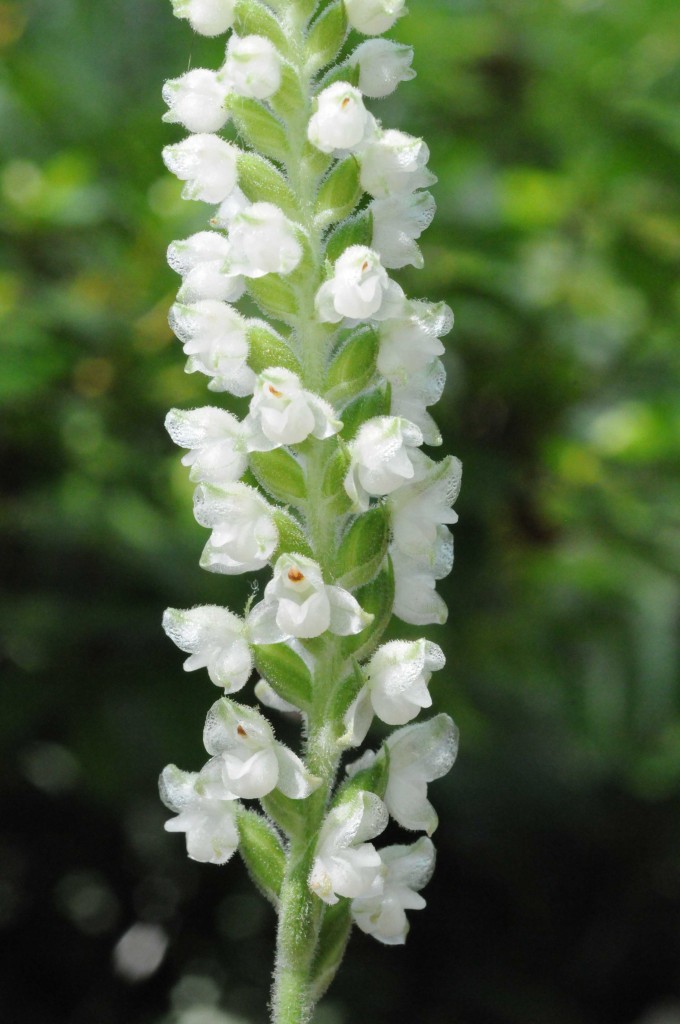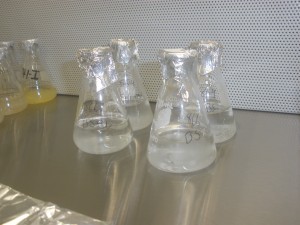By Sarah Hansen

A cluster of downy rattlesnake plantain, the orchid species SERC intern Christopher Robinson is studying this summer. (Wikimedia Commons user Cdc25A)
Orchids are beautiful plants to be treasured, and fungi are gross moldy blobs to avoid at any cost. At least, that’s what some people may think. But it turns out that no orchid can germinate and grow without a fungal partner. Smithsonian Environmental Research Center scientist Melissa McCormick has been learning about the relationship between orchids and fungi for 15 years. This summer, though, intern Christopher Robinson is helping put a new twist on the research.
Robinson is considering the third player in an unexpected ménage a trois – bacteria. Last year, McCormick discovered that bacteria live on and in orchid-associated fungi. Their role in plant growth, though, is still a mystery. Robinson’s job is to help figure out what types of bacteria are present in the fungi that associate with orchid roots and how they affect germination.
“The big end product,” he said, “is to find ways to conserve endangered orchids.” And there are plenty. Of the 200-plus orchids native to North America, more than half are either endangered or threatened somewhere within their native ranges.
In the wild, an orchid allows a fungus to grow into its roots. The fungal threads reach out into the soil farther than the plant’s roots, supplying it with minerals. When the orchid first germinates or is under stress, though, it uses the body of the fungus itself as an energy source.
Knowledge from McCormick’s lab about which fungi and bacteria support orchid growth could bolster conservation efforts. SERC has the largest collection of orchid-associated fungi and orchid seeds in the world. The North American Orchid Conservation Center, a coalition of organizations across the U.S. headquartered at SERC, supports preservation and propagation of endangered orchids.
However, this work has implications far beyond orchids, as McCormick points out. At least 90 percent of land plants require relationships with fungi for successful growth. Some fungi-plant relationships date back to the original evolution of plants on land more than 470 million years ago. The same fungi and bacteria that help orchids grow might also aid crop plants. Providing crops with especially helpful fungi and bacteria could reduce the need for chemical fertilizers that pollute our waterways.
Robinson is working on two main projects this summer related to the orchid-fungus-bacteria trifecta. “It’s nice to have a good balance of lab and field work so that neither becomes too taxing,” he said. Part of his work involves collecting wild samples of orchid roots, and the rest is in the laboratory.
In the lab, he’s growing fungi collected from four different orchid plants. Robinson lets some of each fungal sample grow normally, but he applies antibiotics to the rest to kill their bacteria. Once this is done, both bacteria-rich and bacteria-free fungi from each original orchid are applied to orchid seeds. The goal is to investigate the differences in germination and growth among seeds given fungi with and without bacteria.
A second project uses PCR (polymerase chain reaction), a molecular technique used to create large quantities of specific sections of DNA, and DNA sequencing to identify what strains of bacteria are present in lab-grown versus wild fungi. So far they’ve identified six large groups of bacteria on fungi that form relationships with plants. Figuring out which specific bacteria in fungi are connected to orchid growth—if there is a connection at all—is a key step toward unraveling these complicated relationships.
In the SERC woods on an unusually mild day in June, it still took Robinson a few minutes to find a small cluster of Goodyera pubescens, a small orchid with a flush of deep green leaves covered in net-like white lines. That’s a big improvement since the start of the summer, though. On his first attempt it took over two hours to find the right plant. Robinson doesn’t mind, though. “I love fungi,” he said. “I couldn’t imagine studying anything else.”




